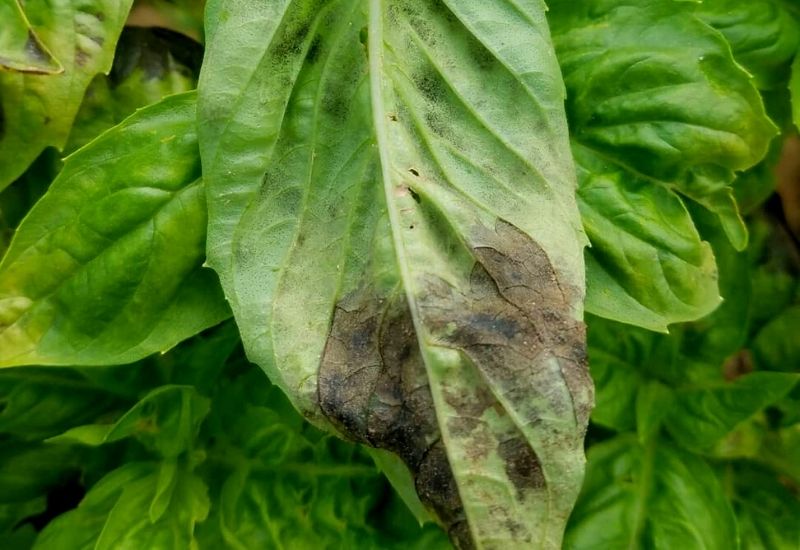
Basil is a heat-loving annual herb that is a staple summertime crop in most kitchen gardens, even for those located in colder climates.
Basil leaves can develop black or brown spots from exposure to frost, bacterial or fungal infections, the presence of pests, or sometimes from a nutrient deficiency in the soil.
If you are finding your basil has begun to show signs of black tips or spots on either side of its leaves, read on to diagnose what is causing basil plant developing black spots, discover how to treat it, and learn all the ways you can prevent the problem from occurring again.
The Common Causes of Black Spots on Basil Leaves
Unfortunately there is no straight answer when it comes to spotting on leaves, as it is a common symptom of multiple underlying issues.
Here are the four most likely reasons why leaves on basil plants are turning black:
1: Exposure to Frost
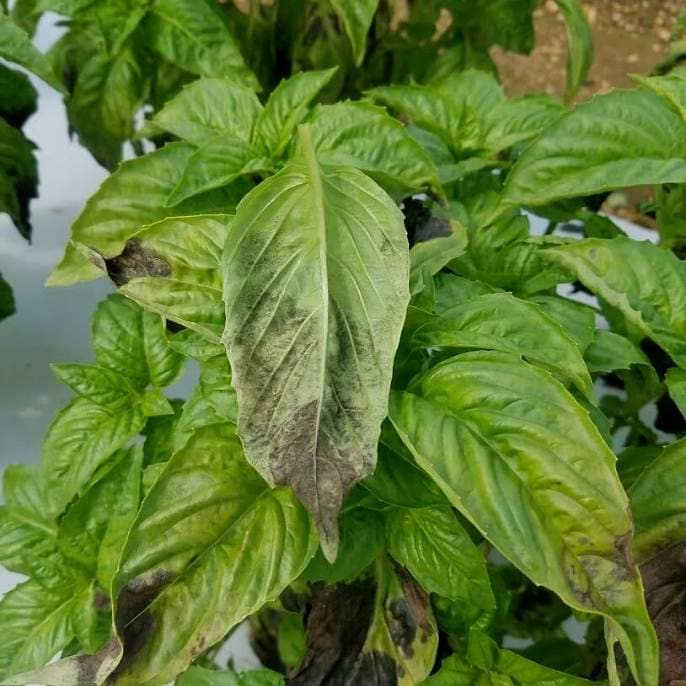
Since basil is a herb native to hot, tropical and subtropical climates, it will not tolerate any exposure to frost or cold temperatures.
When growing basil in temperate climates, if it has been placed outside too early in the season or there is an expected cold snap overnight, your basil will be shocked by the cold and parts of its leaves will begin to blacken and die.
2: Fungal and Bacterial Infections
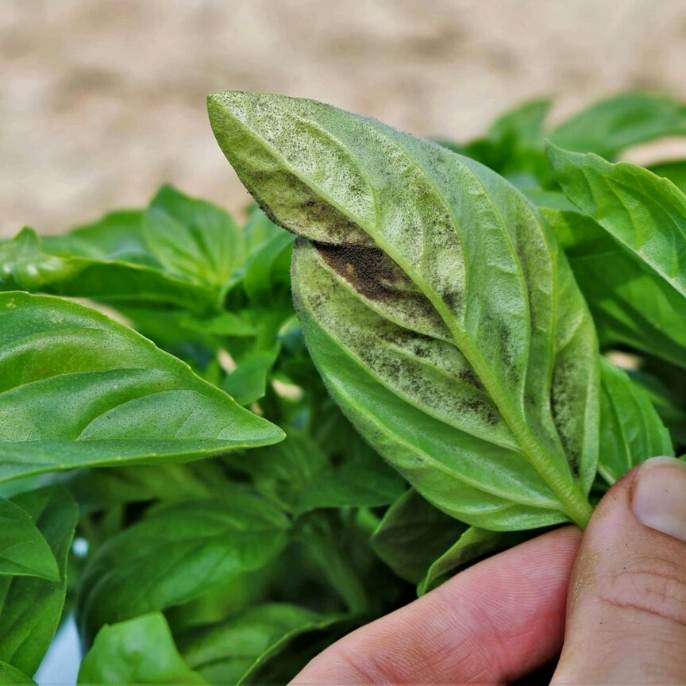
Certain disease pathogens can be transmitted to your basil plants by insects or through water splashing on the leaves of your plant, and can cause black or brown patches to form.
Colletotrichum, Septoria and Cercospora Leaf Spot are fungal infections that can infect your basil plant and result in black or brown spotting on the leaves.
Pseudomonas Cichorii is a bacterial disease that causes wet brown patches to develop on the leaves and stem. Downy mildew is actually a parasitic organism and not a fungus, although the infection closely resembles mould.
3: Pests
There are several pest species that like to feed on basil, such as aphids, thrips, and spider mites. When an infestation is left untreated, you may begin to see small black spots all over the leaves, or leaves that are being punctured and fed on will begin to blacken and eventually fall off.
These pests are more prone to attacking plants that are already in a weakened or vulnerable state, or will spread from nearby plants of the same or different species that are already under attack.
4: Nutrient Deficiencies
Nutrient deficiency is the least likely cause of black spots on your basil leaves, and it is more likely to result in yellowing or curled leaves.
However severe nitrogen deficiencies, or in some cases overapplication, can result in yellowing parts of the leaf dying and turning brown or black in color.
If you come to the point where you have ruled out all other causes, this could be the culprit.
How to Identify the Cause of Black Spots On Basil
Since there are quite a few reasons your basil could be developing black spots on its leaves, let’s take a look at some of the key ways to identify the causes so you can effectively treat them.
1: Emergence after a cold snap
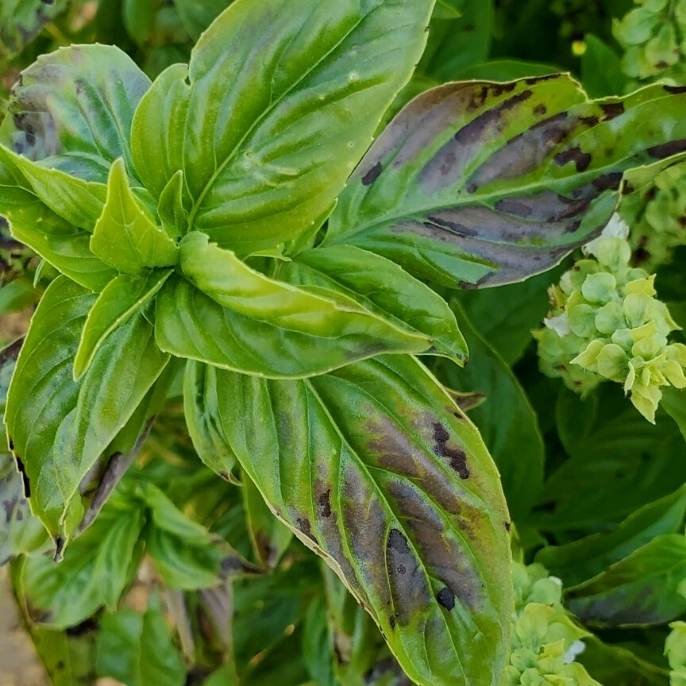
Look back at the weather forecast from the last week and see if there have been any sudden drops in temperature, which would usually have happened over night.
If your basil leaves developed black spotting or tips after a night where the temperature dropped to below 50℉ (10℃), then exposure to cold or freezing temperatures is almost definitely the cause. In this case, whole leaves may turn black or the spots will be quite large.
2: Look at the color of the spots and rings
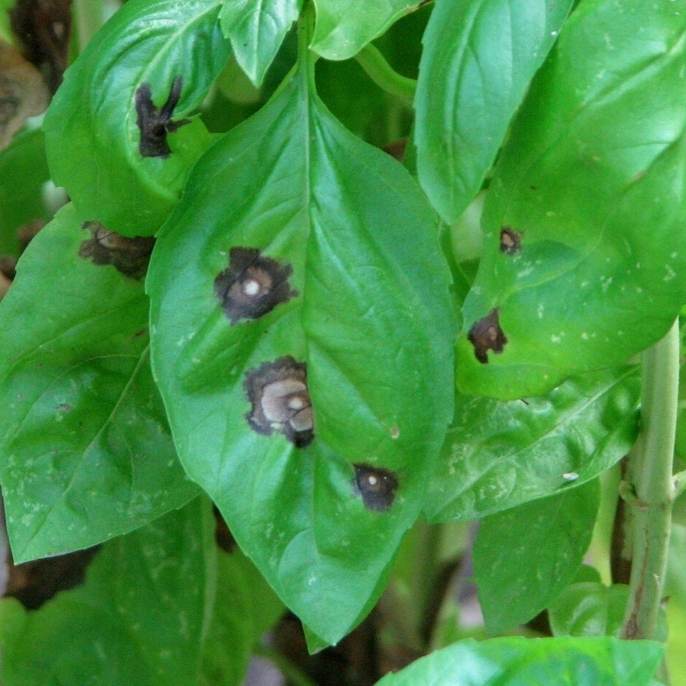
Distinguishing between different fungal and bacterial infections can be tricky, but they tend to have slightly different colorations, textures, or rings around them.
Pseudomonas Cichorii, a bacterial disease, will present wet, dark spots on leaves that will eventually spread and begin to rot the stem.
The fungal disease Colletotrichum will create black spots on the leaves that actually fall out after some time and leave a small hole in the leaf.
Cercospora Leaf Spot can be identified by large black spots that have a yellow ring around them, and eventually will develop a white color in the middle of the spot.
They can also fall out once that part of the leaf has completely died and dried out. Spots caused by the Septoria fungi will be more of a gray/brown instead of black and be surrounded with a dark brown halo.
3: Black spots on the underside of the leaves
If you are seeing black or brown mould-like material on the underside of your basil leaves, it is likely Downy Mildew.
Once it has spread, it will begin to affect the tops of lower leaves as well, but in the initial stages of infection it will only be present underneath leaves and this is the key way to identify it.
4: Webbing, stickiness, or eggs on leaves
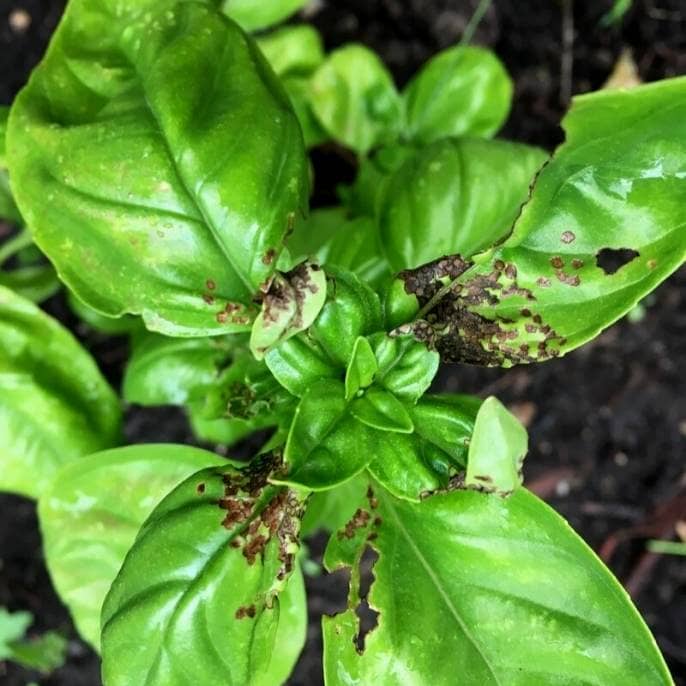
Pests like aphids, thrips, and spider mites will usually leave another sign of their presence aside from black or brown spots on the leaves of your basil plant.
The black spots themselves are sometimes where the plant tissue has been eaten away, but more often is actually the feces of the insects (yikes right?).
Thrips are very small and pale in color, making them difficult to spot, but they lay their eggs in the leaf tissue so look for little bumps on the leaf surface.
Aphids are a little larger and can actually be spotted if you look closely at the leaves, but will also leave a sticky clear fluid excrement on the leaves that looks a bit like honey.
Spider mites are teeny tiny (only about a millimeter long!) but leave their trademark fine webbing between leaves and at the base of the stem.
Treating the Different Causes of Spotted Leaves
Hopefully at this point you have identified the cause of your black spots, or at least narrowed it down to a couple of suspects. The next step is to this guide to treat your basil plant so that it can recover and continue producing for the rest of the season:
Exposure to Frost
If your basil was exposed to frosty or very cold temperatures, there isn’t much that can be done to ‘cure’ the spots except to remove all affected leaves.
The black spots are signs of necrosis, which cannot be reversed and will spread if left on the plant.
Prune away dead or dying leaves, make sure your plant is not exposed to cold temperatures again, and hope for a full recovery.
Fungal and Bacterial Infections
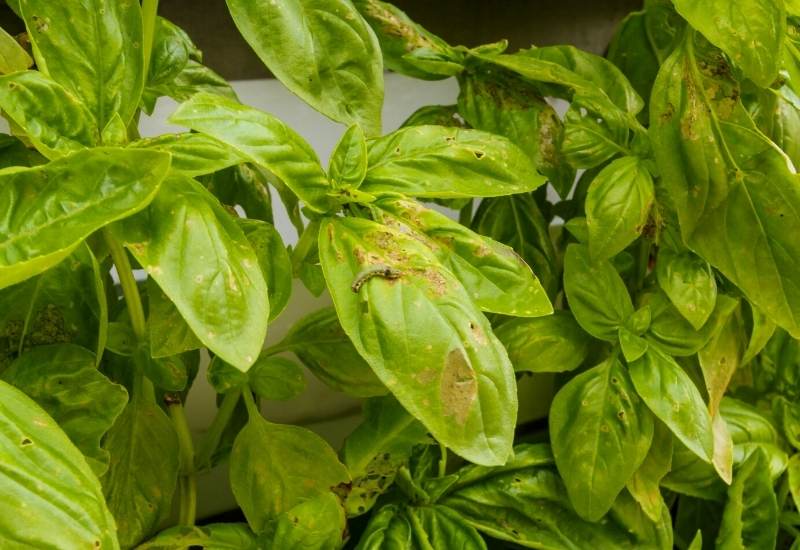
Depending on what stage of infection your plants are at, fungal infections can be treated with an organic bicarbonate-based fungicide.
Prune affected leaves off before application. Homemade sprays using a few drops of natural dish soap, a half teaspoon of baking soda, and one litter of water can be effective on powdery mildew if it has been identified early on.
If the fungal or bacterial infection is severe, you will need to remove the infected plant or plants to prevent its spread to other crops (basil or otherwise).
Plants should be burnt or thrown away, not put on the compost pile where spores will survive and spread around the garden.
Pests
Aphids, thrips, and spider mites can all be treated with neem oil, an organic pesticide that is naturally derived (as opposed to synthetic pesticides which can be destructive to other insects and your soil) from the neem tree.
The same dish soap/baking soda spray used for fungal infections can also be effective for spider mites.
Heavily damaged leaves should be removed, and potted basil plants should be repotted with fresh soil to prevent any eggs from surviving underground.
Nutrient Deficiencies
If you believe your basil is developing black or brown spotting from a nutrient deficiency, the best way to treat it and simultaneously confirm this is the cause is to adjust your fertilizing schedule.
If you haven’t been fertilizing your basil plants at all, amend the soil surface with compost or an organic fertilizer that is high in nitrogen and see if it makes a difference.
Vice versa, if you have been fertilizing heavily give your plant a break for a month and see if it makes a recovery. As with the other causes, prune away affected leaves.
Preventing Your Basil From Developing Black Spots
Prevention is the most effective way to keep your plants healthy, as once diseases or pests have entered your garden it is much trickier to get rid of them than to keep them out in the first place.
To ensure your basil plants stay healthy and resilient to threats the most important thing to keep in mind is creating its optimal growing environment.
Heat, sunlight, good air circulation, adequate nutrition, and semi-dry conditions are key for basil to thrive.
Here are some steps you can take to prevent black spotting:

Written By
Amber Noyes
Amber Noyes was born and raised in a suburban California town, San Mateo. She holds a master’s degree in horticulture from the University of California as well as a BS in Biology from the University of San Francisco. With experience working on an organic farm, water conservation research, farmers’ markets, and plant nursery, she understands what makes plants thrive and how we can better understand the connection between microclimate and plant health. When she’s not on the land, Amber loves informing people of new ideas/things related to gardening, especially organic gardening, houseplants, and growing plants in a small space.
